How to insulate a gas cylinder on the street in winter: the best ways to warm
Cylinder gas is classified as a “summer cottage” option for fuel delivery and is used where it is not possible to connect to the gas main. If for a stove one cylinder with propane-butane is enough, then several have to be connected for servicing the boiler.
Using tanks filled with liquefied gas is simple, but in winter there may be problems - the gas freezes or falls out in the form of condensate. As a result, the stove or boiler ceases to function. We will figure out how to insulate a gas cylinder on the street in winter so that the fuel supply to the house is stable.
The content of the article:
Rules for installing gas cylinders
The need for heating gas cylinders arises when low street temperature cools them, which slows down gas production. As a result, the working volume of fuel is reduced, it is necessary to produce more often gas station.
In addition, there is a risk condensation, which also impedes the flow of gas to the burners - for example, to a stove or boiler.
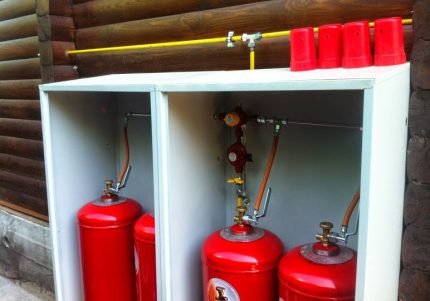
The metal walls of the cabinet protect the cylinders from mechanical damage, wind and moisture, but do not heat them. The air temperature inside the casing is equal to the outdoor temperature. Cold is transferred to the tank body and cools the fuel, which is in a liquid state. At low temperatures, the transition to a gaseous state is hindered, condensation occurs, and the properties of the fuel change.
The most negative consequence of the action of the cold is a stop in the supply of fuel to the house, which can block all economic activity.
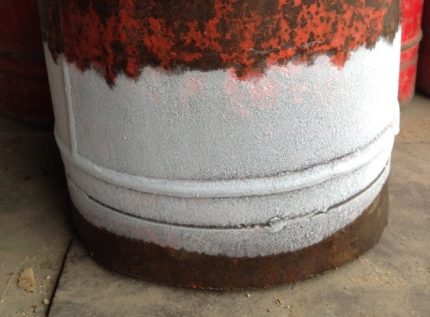
For refueling, two components are used - butane and propane. They differ in characteristics: liquefied butane at low temperatures loses its properties, and propane, on the contrary, does not work in the heat.
By combining the components in standard proportions, they get the optimal mixture for use in the climatic conditions of a particular region. Read more about the proportions of different types of gas in the mixture - in GOST 20448-90.

The regulatory documentation on cylinder insulation technologies does not say anything. For example, in SNiP 31-02 - the main document on the gas supply of a country house - the requirements are set out only for the installation of fuel sources, information on thermal insulation is missing. That is why gas workers recommend not insulating the cylinders.
Ways of warming cylinders on the street
To save gas mixtures in working condition, the cylinders are insulated in various ways. Some of them are effective, others are useless, and others can be life threatening.
We will find out what is the best way to insulate a gas bottle on the street in winter so that there are no problems with the supply of fuel, and the residents could not worry about their own health.
Method # 1 - thermal insulation materials
Despite the prohibitions of gas service employees, owners of private houses often “wrap” cylinders with all kinds of heaters: mineral wool and glass wool, sheets of expanded polystyrene and foam rubber — that is, household heaters that are actively used in building houses, erecting roofs, and flooring.

In fact, wrapping containers with insulation is a frankly primitive and ineffective way to warm gas in cylinders.
Why does this method not work? The fact is that heat-insulating “blankets” are good if the object independently generates heat.

Gas cylinders do not produce any heat, therefore, even wrapped in three layers of mineral wool or polystyrene foam, they remain as cold. Accordingly, liquefied fuel inside does not change its characteristics - that is, no positive changes occur.
Conclusion: if the gas cylinder does not generate heat on its own, this function should be performed by the conditional “insulation” - a device that receives electrical power.
We turn to heat-insulating technologies that can really make a difference and warm gas in cylinders in the winter.
Method # 2 - heating cable
Provided that a serviceable vessel is used, and its installation is made in accordance with all the rules, they use the heating of the gas cylinder with an electric heating cable.
There are many options for thermal insulation systems - from purchased self-regulating cables to homemade products assembled from a wire and a temperature regulator.
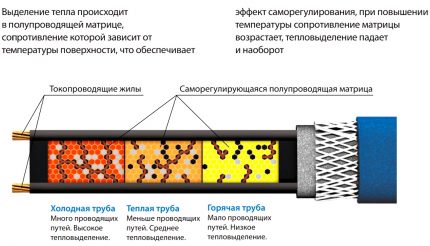
To adjust the temperature, the wire is connected to the thermostat. Using mechanical models, you can manually set the operating parameters. Self-regulating cables operate in automatic mode and do not require constant monitoring.
To create a home-made insulation system for 3 cylinders, you will need:
- 9-meter electric wire 3 * 1.5;
- 3 temperature controllers - 1 for each cylinder;
- 25 m of thermal insulation material “thermofol”;
- 3 m PVC film;
- 3 m IR film;
- 12 couplers for fixing the insulation;
- mounting kit.
First, the container is wrapped with ordinary PVC film, then with infrared, to which a power cable with a temperature controller is connected. To keep warm, put on a cover from "thermofol" from above and fix it with couplers.
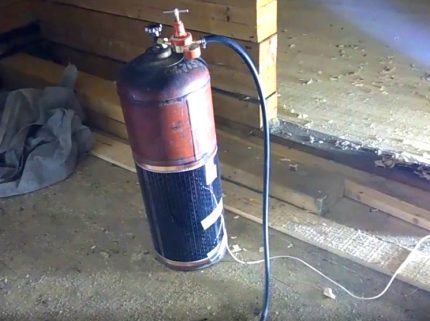
The method cannot be called the safest, because the proximity of electric cables and a gas tank under certain conditions is risky.
But if you follow the installation rules and safety precautions, the device can be used throughout the cold season.
Method # 3 - electrical devices
The principle of heating with a heating cable was taken into account, and due to the unquenchable demand for gas cylinders, the most enterprising manufacturers began to produce electric "heating pads". They guarantee high-quality thermal insulation of the cylinders and preservation of the properties of the gas, in which it does not lose its working functions.
Two effective and safe devices can be distinguished:
- thermal blanket for a gas cylinder;
- heater.
Thermal blanket designed to heat standard 50 liter gas cylinders. It is estimated that in the cold season it can save up to 30% of liquefied fuel due to the fact that propane evaporation occurs stably, condensate does not precipitate and refueling is much less common.
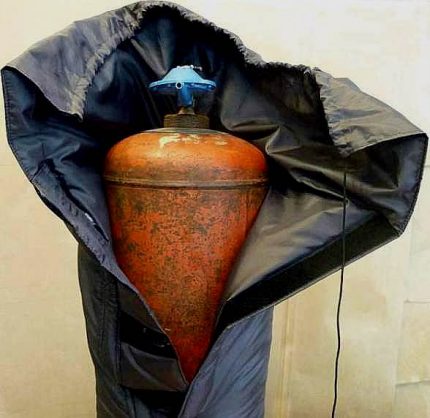
The sizes of electric blankets can be different. In addition to standard covers for cylinders, products are also made for heating gas holders. Maintained temperature - +40 ° С (± 5 ° C), power - about 160 W. Energy consumption is economical: at an outdoor temperature of -15 ° С the blanket consumes no more than 80 W / h.
Electric heater differ from the thermal blanket in size: it does not completely close the cylinder, but only its lower part. But the principle of operation is the same: electricity generates heat, which is constantly transmitted to the body of the cylinder.
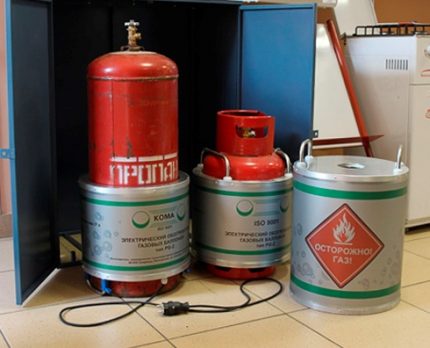
Heaters are produced for cylinders of 27 and 50 liters, the heating temperature is +40 ° C. The degree of protection is IP 44, that is, the product can also be used outdoors, provided that the cylinders are enclosed in a metal cabinet.
An alternative way is a warm room
In order not to look for ways to insulate the tanks installed on the street, you can do simpler - transfer the cylinders to a heated room. In comfortable conditions, the cylinders "give" almost the entire amount of fuel, so refueling should be done less frequently, and there are no problems with the movement of gas inside the supply system.
The main thing is to follow the installation and operation rules:
- the cylinder is installed vertically;
- the vessel must be accessible for maintenance, inspection or replacement;
- the distance from the tank to the stove - not less than half a meter, to the radiator or stove - not less than 1 m;
- if the furnace is opposite, the distance is increased to a minimum of 2 m.
One of the main requirements concerns the choice of room for installation.
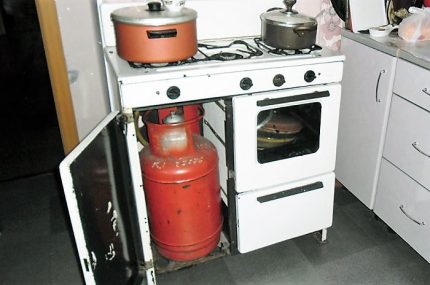
A tank with liquefied gas is usually installed either directly next to the stove, or in an adjacent non-residential premises, throwing the fuel supply hose through an opening in the wall.
Cylinders must not be kept in basements, basements and any other premises that are not equipped with ventilation or a ventilation system.
And remember the important condition: if your house has more than 2 floors, the placement of any gas tanks inside the building is prohibited!
How to warm gas during freezing?
Consider the last questions: what to do if the gas is already frozen and how is it allowed to warm up a gas bottle in winter?
If you notice that the vessel body covered with hoarfrost, fuel flow to the burners is difficult or completely stopped, you can try to warm the cylinder.
In no case can sources of open flame be used - bring lighters, burners, blowtorches, a burning torch, etc. to the body. An explosion may occur with unpleasant consequences.
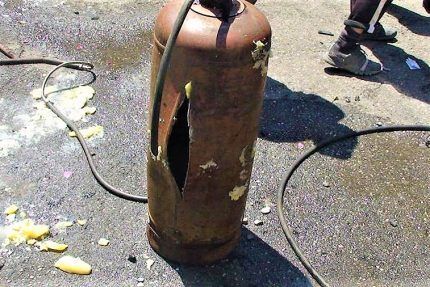
Methods that can be used for one-time, emergency heating:
- Pour hot water into the vessel or expose it to hot steam. The procedure must be performed slowly, with the valve closed. In the end you should blow gearboxto remove moisture.
- Use a chemical or salt heating pad, as is the case under field conditions. Chemical heating pads are disposable and last 6-7 hours. Saline ones are reusable, but the heating temperature is up to +50 ° С, whereas the recommended one is +40 ° С.
- Temporary transfer of the vessel to a warm room. Heating will be more effective if the cylinder is placed near the radiator for a short while.
These measures will not save the fuel source from subsequent freezing, but are able to help out in an emergency.
Conclusions and useful video on the topic
The simplest insulation with a self-regulating cable:
An example of a homemade heater - video instruction:
Option for heating the box for cylinders:
The question of whether it is possible to warm a gas cylinder on our own remains an open question. If you determine that the fuel supply system has stopped working due to vessel cooling, we recommend that you use safe and authorized methods, taking into account all requirements.
Otherwise, you can “earn” penalties from gas service employees or, even worse, endanger the lives of residents.
Please share your experience if you have ever heated a cylinder in the winter. Leave your comments, make suggestions - the block for communication is located under the article.

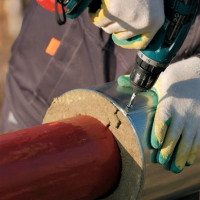 How to insulate a gas pipe on the street from condensation: an overview of the best materials and installation instructions
How to insulate a gas pipe on the street from condensation: an overview of the best materials and installation instructions 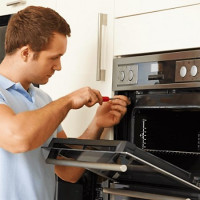 How to connect the built-in gas oven: a detailed briefing with useful tips
How to connect the built-in gas oven: a detailed briefing with useful tips 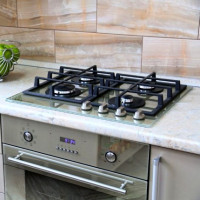 Gas hob connection: safe connection instruction
Gas hob connection: safe connection instruction 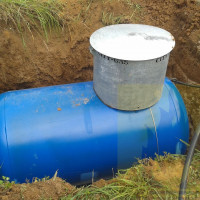 Autonomous gasification of a private house: arrangement of a gas supply system for cylinders and a gas tank
Autonomous gasification of a private house: arrangement of a gas supply system for cylinders and a gas tank  Laying a gas pipeline in a case through a wall: the specifics of a device for introducing a pipe for gas into a house
Laying a gas pipeline in a case through a wall: the specifics of a device for introducing a pipe for gas into a house  How to conduct gas in the bathhouse from home: the subtleties of gasification of the bath
How to conduct gas in the bathhouse from home: the subtleties of gasification of the bath  How much does it cost to connect gas to a private house: the price of organizing gas supply
How much does it cost to connect gas to a private house: the price of organizing gas supply  The best washing machines with dryer: model rating and customer tips
The best washing machines with dryer: model rating and customer tips  What is the color temperature of light and the nuances of choosing the temperature of the lamps to suit your needs
What is the color temperature of light and the nuances of choosing the temperature of the lamps to suit your needs  Replacement of a geyser in an apartment: replacement paperwork + basic norms and requirements
Replacement of a geyser in an apartment: replacement paperwork + basic norms and requirements